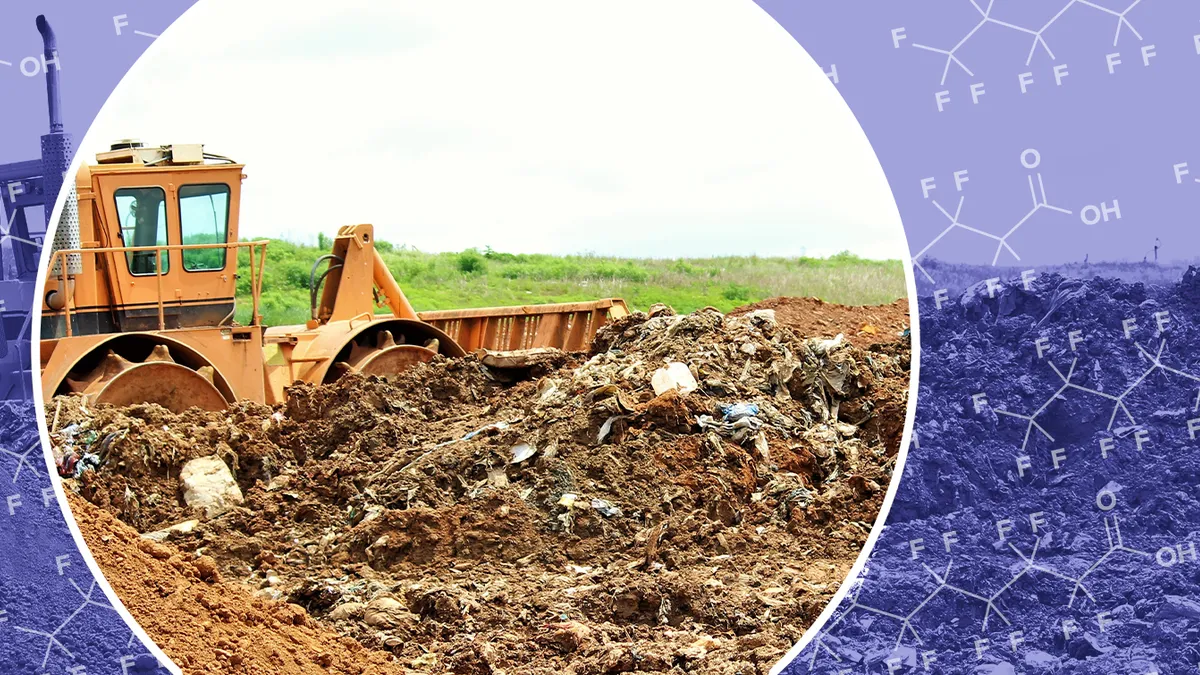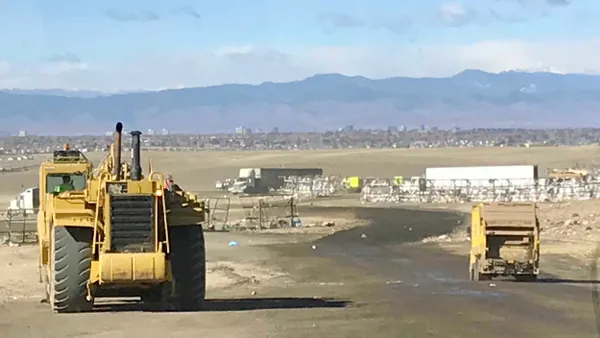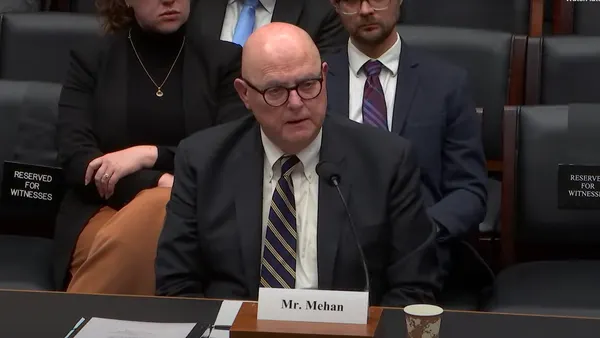Dive Brief:
- New analysis from the Environmental Working Group (EWG) argues that a number of landfills and other waste sites could be discharging toxic "forever chemicals" into the air and water. The environmental advocacy organization looked at more than 2,500 industrial facilities across the country as part of its research on per- and polyfluoroalkyl substances (PFAS).
- Included in the more than 30 sites listed by the group are facilities operated by Waste Management, Republic Services, Clean Harbors, Veolia North America, US Ecology and Illinois-based Peoria Disposal Co. (PDC), among others. "We disagree with any suggestion in the report that the Waste Management landfills present any threat to public health or the environment," Janette Micelli, a spokesperson for the company, told Waste Dive.
- The report's findings are only "suspected" and do not firmly establish those facilities as confirmed sources of PFAS. EWG asserts a lack of oversight and mandated testing by the U.S. EPA has limited available data on PFAS sources. Lawmakers supportive of regulating PFAS argued in a call last week that the COVID-19 pandemic has underscored the importance of public health, potentially generating more oversight from Congress.
Dive Insight:
PFAS, the family of chemicals linked to cancer and other deadly illnesses, are found in virtually every landfill. The non-stick chemicals are present in a range of everyday items from cooking pans to dental floss and eventually emerge in the waste stream.
In its analysis, EWG found 2,501 industrial facilities it believes could be discharging PFAS. EWG used two online EPA databases for the research, as well as a New York survey and an internal 2017 EPA memo.
During a call with reporters discussing the findings, EWG Senior Vice President for Government Affairs Scott Faber said 2,467 of those sites have already reported releases of non-PFAS toxic chemicals designated under the EPA's Toxic Release Inventory.
"Industrial discharges are the most significant sources of PFAS entering our water sources and our air," Faber argued.
Waste sites are among the types of industry operations EWG singled out in its research. At least 36 locations were cited for potential PFAS discharge, including sites owned by Waste Management subsidiaries in California, Illinois and Oregon; a site owned by a Republic subsidiary in New York; and Illinois sites owned by PDC and Veolia.
"Since PFAS are not regulated as hazardous wastes, they may move through many facilities in our logistics network, and the ultimate disposal facility, which is typically a thermal treatment, is selected by our customers," Veolia North America Senior Vice President Bob Cappadona told Waste Dive.
The company has previously expressed interest in PFAS management as a business opportunity, given growing interest in safely disposing of the chemicals. Cappadona also underscored that clients sometimes require disposal of items that may contain PFAS.
"We are responsive to the needs of our customers," Cappadona said.
Micelli of Waste Management similarly underscored the company "does not manufacture, produce or generate PFAS," but rather provides "the essential public service of disposing of the PFAS materials at our landfills that other companies have manufactured or used."
Prior to the outbreak of the new coronavirus pandemic, efforts to regulate PFAS were picking up steam on a statewide level. The EPA has faced criticism for failing to set a maximum contaminant level for any PFAS, but states have moved forward with regulations. In places like Michigan and Vermont, that has meant an uptick in testing, resulting in more data about the chemicals and their sources.
David Andrews, a senior scientist with EWG, told Waste Dive the findings "highlight the importance" of scrutinizing waste sites. Testing in states such as Michigan, he said, has shown "landfills are actually one of the more common sites across the state."
As effects associated with the coronavirus have ramped up, some scrutiny of PFAS has fallen by the wayside. It has stalled testing in Ohio's public water systems, for example. But the issue remains a pertinent one for many communities — last week, VTDigger reported the spreading of biosolids on farm fields is seemingly contaminating groundwater in those areas with PFAS.
And lawmakers have indicated the issue isn't going away. Reps. Chris Pappas (D-N.H.) and Harley Rouda (D-Calif.) said in an April 9 call discussing EWG's findings that they bolster support for congressional action. "I think we're seeing growing bipartisan interest in this particular issue because everyone has it in their backyard," said Pappas.
Both congressmen also pointed to the pandemic as an indicator that public health could become more of a priority in the future, potentially accelerating efforts to regulate PFAS. "Kind of like the pandemic we're dealing with right now, if you test you will find [it]," said Rouda, who went on to argue "we can stop what's going to be one of the biggest cleanups [in history] if we regulate."
Whether or not that regulation will sharpen oversight of the waste industry is unclear, but Andrews of EWG indicated the inclusion of waste sites in the recent research highlights growing awareness around the presence of PFAS at those sites.
"I think we'll see increased focus on the waste industry," he said.
Correction: This story has been updated to reflect that Veolia's facility in Sauget, Illinois is not a landfill, as characterized in the EWG report. That waste site is an incinerator.









